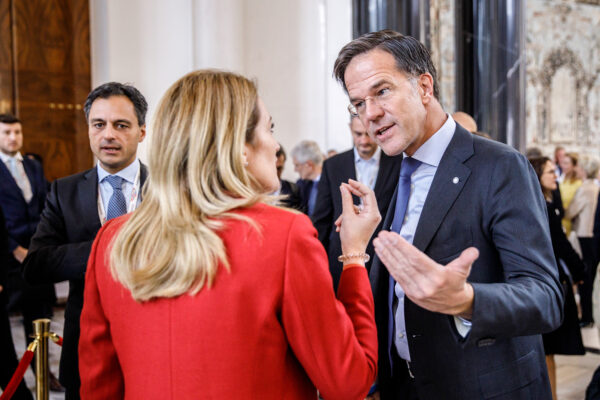
Dutch prime minister Mark Rutte is arguing for stricter European asylum rules and finding a listening ear in Brussels.
“What you see is that everyone fell asleep a little during corona,” he said after meeting with European Commission president Ursula von der Leyen, whose proposals match his own. “At the time, the asylum figures were very low.”
An increase in applications after COVID overwhelmed the Dutch immigration system. Several hundred asylum seekers had to camp and sleep outside the application center in Ter Apel, where there weren’t enough beds free.
Asylum applications doubled in 2022
Irregular migration to Europe jumped to 330,000 last year, according to the border agency Frontex: the highest since 2016. Asylum applications doubled between 2021 and 2022 to 924,000.
Some 550,000 asylum seekers are waiting to hear if they can stay. The largest groups are Syrians and Afghans.
Migrants who are denied asylum seldom return to their home country. In 2021, the most recent year for which full data is available, a quarter of 342,000 rejected asylum seekers were returned to a country outside the EU. The rest stayed in the EU illegally, including to try for asylum in another member state. (Where they would almost certainly be denied again.)
One in three asylum seekers apply in Germany. France takes 19 percent of applications, the Netherlands 4 percent.
The figures include few Ukrainians, who can remain in the EU for up to three years without applying for a status.
Dutch struggle to cope with increase
The Netherlands’ share of European asylum applications may be proportionate to its share of the European population, but the country has struggled to cope with the increase.
There are 52,000 asylum seekers in the Dutch system, up from 36,000 a year ago and 29,000 in 2016. A third — 17,000 — have been granted asylum but can’t move out, because they can’t afford to buy or rent a home and there is a shortage of subsidized housing.
Nieuwsuur reports that immigration authorities expect a shortage of 38,000 beds this year. Reports leaked to the NRC newspaper warn of “social disruption” when thousands of asylum seekers are unable to find shelter.
Rutte’s government, a coalition of four center-right parties, forced municipalities that housed few or no asylum seekers to take their “fair share”, but that offended members of his own liberal party (of which I am one). Rutte avoided a wider party rebellion by promising to bring down the overall number of asylum seekers.
The only concrete step his government took — suspending family reunifications — was reversed by a judge for violating the UN treaty on the rights of refugees.
What Rutte wants
Controlling migration in the open-borders Schengen Area of the EU requires an EU policy. Rutte has made four proposals.
- Enforce the so-called Dublin Regulation: asylum applications must be made and reviewed in the first member state where asylum seekers arrive.
The regulation has not been enforced since 2015, when border states like Greece and Italy where overwhelmed by an influx of Syrian and other refugees and Germany accepted applications from asylum seekers who had traveled through other EU countries.
- Sanction visa partners that don’t control their border.
Several non-EU countries have visa-free travel with the EU, including Serbia. It is accused of not securing its border, allowing a “backdoor” for irregular migration into the EU.
- Improve cooperation with non-EU countries “to decrease irregular migration and foster return.”
Rutte’s template is the 2016 deal he helped negotiate with Turkey, which gives Turkey EU funds to shelter Syrian refugees and under which the EU pledged to accept one Syrian refugee for every irregular migrant Turkey took back. You might call this the “carrot”.
- Wield developmental aid, trade and visas as levers to cut irregular migration and improve returns.
This is the stick. It means if third countries — most are in North and West Africa — refuse to take citizens back who have been denied asylum in the EU, the EU would cut their developmental assistance or trade or suspend visa applications.
Commission agrees
“We do not need to wait for legislation on the pact to do this,” the European commissioner for home affairs, Ylva Johansson, points out. Member states can already apply visa restrictions for countries with low rates of migrant returns.
The “pact” is the Pact on Migration and Asylum, for which the commission proposed reforms in 2020. Those have stalled due to opposition from various member states, including the Netherlands and Johansson’s Sweden.
At the heart of the reforms is a tradeoff: border states get help to register every migrant who travels into the EU and all member states contribute proportionately to sheltering those who are accepted as refugees.
Countries like the Netherlands are wary so long as the EU’s external borders aren’t secure.
An alternative would be to let countries that refuse to take (more) asylum seekers pay more toward border security.
Processing asylum applications abroad
The leader of Rutte’s liberal party in the European Parliament, Malik Azmani, has proposed to set up reception centers for asylum seekers outside the EU. That plan was recently endorsed by the governments of Denmark and Italy
It would require agreements with host countries like Libya and Tunisia. And it would mean dispatching European immigration officials and possibly Frontex border guards to third countries.
But it could also discourage irregular, and dangerous, migration across the Mediterranean Sea and enable migrant-sharing in the EU. Migrants who are recognized as refugees could be flown into Europe.
Leaders will meet in February to discuss asylum reform.
